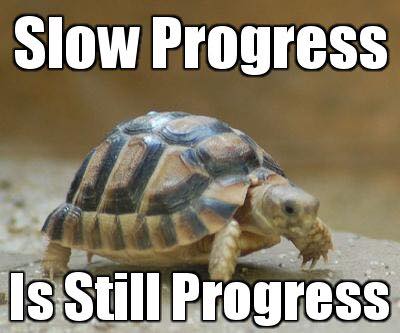
To reach success you must have the right yardstick to give you a clear picture of where you stand. Using the right parameters will also help you stay motivated. Learn five different methods to evaluate your progress and stay on track with your goals. (Estimated reading time: 5-6 minutes)
“Progress is the ultimate motivation.”
— Tony Robbins
Progress is fundamental to human nature. It’s what led to humanity’s enormous advancement over the past couple of centuries.
Life expectancy has increased thanks to better sanitation and advancements in medicine. More children have access to education than ever before, and women can hold leadership roles in politics and business. Cellphones, the internet, and air travel have made us a connected, global society. The fight for human rights has brought more fairness and justice to the oppressed.
When seen from a birds-eye view, it looks like the timeline of human progress has followed a linear trajectory. But when you look closer, you’ll see that’s a false notion.
There were years, and even decades, when society took one step forward and two steps back. Events like the World Wars, corrupt political and military regimes, the Great Depression, and the recent COVID-19 pandemic are prime examples of this.
People living through these difficult times are prone to expect the worst and give up. But it’s precisely during these dark times that we must push harder to stay on course. Pushing through the darkness works even with the everyday challenges we encounter.

I know it’s easier said than done. I’ve been through experiences when I felt like I was dragging myself through mud. I was putting in long hours, taking calculated risks, and staying committed to the process, but there were no payoffs from my efforts. After a while, I would ask myself, “What’s the point?”
Over the years, I’ve grown to see these blocks as opportunities instead of obstacles. When there were no obvious markers of progress, I took it as a sign that there must be a shift in my attitude and perspective, as well as my strategy.
Leonardo Da Vinci adopted the motto “ostinato rigore,” which translates to “tenacious application” or “stubborn rigor.” He knew that one of the biggest pitfalls, one that befalls even the most disciplined, is impatience. Not only can it make us quit prematurely, but it can affect the quality of our work. We get tempted to take shortcuts and replace originality with old ideas.
To combat this, Da Vinci followed a rigorous protocol for every project. He learned to find pleasure in the painful phases—where the real work happens. Like an athlete engaged in rigorous practice who pushes past her limits, Da Vinci was able to overcome his natural impatience and resist taking the easy way out when creating his masterpieces.
Our lack of progress signals a need to alter our strategy. A common mistake is not using the right metrics to measure progress. In other words, you must have the right yardstick to give you a clear picture of where you stand.

In the world of commerce, performance measurement is the lifeblood of business growth. One of the key challenges of performance management is choosing what to measure. A good measurement system uses measurable values called KPI’s (Key Performance Indicators) to show how effectively a company is achieving its business objectives.
KPI’s vary for each business type and each department. They vary from quantifiable measures like profitability, through to qualitative measures like customer satisfaction. Knowing what to measure puts a business in a stronger position to monitor and manage performance.
If we’re serious about achieving results and making consistent progress in life, we, too, need to establish clear targets and keep track of our performance. However, unlike managers who have CEO’s and company shareholders squeezing them for reports with detailed metrics, we are on our own when it comes to recording and evaluating our efforts.
Using the right parameters to measure our progress is essential to staying motivated. Choosing the right KPIs ensures that we feel rewarded every time we hit milestones (no matter how big or small) along the way.
Here are five different ways to evaluate progress and stay motivated:
1. Numbers: When accurate, numbers don’t lie. In some cases, it’s impossible to measure progress without a measurable unit that you can track. If you want to lose or gain weight, you must pay attention to fluctuations in your weight and body fat. Saving for retirement requires that you watch your spending and your bank balance. Time management entails looking at the clock and regulating how we use it. Quantifying gives us clarity about our degree of success and where we stand based on parameters that are universally accepted.
2. Past performance: If you’ve been working on a certain goal for a while, you can get a good sense of your progress by seeing how far you’ve come since you started. Whether you use numbers or your own perception to assess your mileage, it can be incredibly motivating to look back on how much you have accomplished. Doing this also confirms whether you’re on the right track, and where you may end up based on your current trajectory.
3. Others’ feedback: Getting feedback from people who are credible, neutral, and well-meaning can be an effective way to measure progress. Our ego and blind spots can often make it hard to stay objective and honest about our performance. Constructive advice offered respectfully helps you improve on important aspects of projects that you may have missed. Mentors, coaches, Mastermind groups, and accountability partners are examples of sources you can consult.
4. Future aspirations: An alternative way to view progress is by measuring how far you need to go. Looking at how much further you have left to travel until you reach your target can build anticipation and excitement if your goals are not too distant. If you have a while left until you get close to your destination, you might want to avoid this technique as it can be demoralizing. It’s also not going to be helpful if you don’t have a clear end goal or defined target in mind.
5. Your own assessment: Deep down, we’re aware of our capabilities and whether or not we’re giving our all. Our inner compass can give us an intuitive sense of how we’re contributing to that progress. Considering your own performance can provide insight into your strengths and areas you can work on. Reflect on your progress by penning your thoughts in a journal or speaking with someone.
Expressing your thoughts gives them form and structure, making them easier to understand. When doing this, watch out for common pitfalls such as your inner critic that minimizes and belittles your success or falsely inflates them.
No matter where you are on your path to progress, celebrate every step. Most of your life will be defined by time spent walking toward your dreams. Setting milestones along the way not only motivates you but fortifies you with strength and courage to keep moving forward no matter what.
All my best on your journey,
Seline

Question for you: How do you stay motivated while tackling your projects? Does your evaluation method boost your motivation?
Did you like this post? Sign up below, and I’ll send you more awesome posts like this every week

Thanks for this. At atime in my life i need the encouragements, A lot is going on. Lots of stress and uneasiness. Makes it hard to stay motivated. But there are some really good points in this. Will definitely be reviewing this blog again and again!
I think most of us feel this way if we were to be honest with ourselves. It is a difficult time, even just considering a few of the things being thrown at us these days. But when you take it all into account, it is a wonder any of us are still functioning. It is a struggle, but I know we are going to get through these times and come out on the other side better for it!